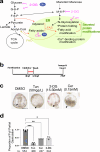Unique metabolic regulation of micromeres contributes to gastrulation in the sea urchin embryo
- PMID: 40790037
- PMCID: PMC12340151
- DOI: 10.1038/s41467-025-62697-8
Unique metabolic regulation of micromeres contributes to gastrulation in the sea urchin embryo
Abstract
During development, a group of cells called organizers plays critical roles by sending signals to adjacent cells and controlling embryonic and tissue patterning. Recent studies suggest that these inductive cells facilitate the downstream signaling pathways conserved across organisms. However, what makes these cells fundamentally inductive is little understood. In this study, we demonstrate that the micromeres of the sea urchin, one of the known organizers, have distinct metabolic properties compared to the rest of the embryo. The specific metabolic inhibitors for sugar metabolism (2-DG), fatty acid synthesis (cerulenin), and N-linked glycosylation (tunicamycin) compromise micromeres' regulatory capacity, altering the downstream germ layer patterning in the resultant embryos. Notably, the endoplasmic reticulum (ER) asymmetrically localizes during asymmetric cell division, resulting in the enrichment of ER and Wnt protein at the vegetal cortex of micromeres. Metabolic inhibition appears to compromise ER activity in Wnt particle distribution. We propose that the micromere ER is sensitive to specific metabolic regulation, contributing to the inductive signaling activity. This study provides a paradigm of how ER and metabolic regulation contribute to the inductive capability of the cells.
© 2025. The Author(s).
Conflict of interest statement
Competing interests: The authors declare no competing interests.
Figures







References
-
- Spemann, H. & Mangold, H. U¨ ber die induktion von embryonalanlagen durch implantation artfremder organisatoren. Wilhelm Rouxs Arch. mikrosk. Anat. Entwickl.100, 599–638 (1924).
-
- Boveri, T. Verhandl. Der. Phys. Med. Geselsch. Wurzbg.34, 145–176 (1901).
-
- Horstadius, S. Uber die determination des keimes bei echinodermen. Acta Zool.9, 1–191 (1928).
-
- Horstadius, S. The mechanics of sea urchin development. Annee Biol.26, 381–398 (1950). - PubMed
-
- Horstadius, S. Experimental Embryology of Echinoderms (Clarendon Press, Oxford, 1973).
MeSH terms
Substances
Grants and funding
- R01 GM126043/GM/NIGMS NIH HHS/United States
- R21 HD109132/HD/NICHD NIH HHS/United States
- 1R21HD109132-01/U.S. Department of Health & Human Services | NIH | Eunice Kennedy Shriver National Institute of Child Health and Human Development (NICHD)
- P20 GM109035/GM/NIGMS NIH HHS/United States
- IOS-1940975/National Science Foundation (NSF)
LinkOut - more resources
Full Text Sources

